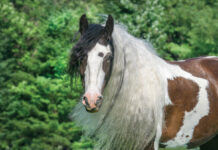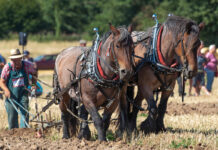Thumb through an old history book and you can’t help but notice the impressive horses ridden by cavalry officers. Many of them were old-fashioned Saddlebreds or heavy-boned horses with extensive Saddlebred bloodlines. A classic example was General Robert E. Lee’s horse, Traveller, who was the general’s mount of choice for numerous battle campaigns.
Today, there are approximately 1,200 registered Georgian Grandes located in North America, Europe, Australia and New Zealand. They are used for dressage, eventing, show jumping, hunt seat, English pleasure and driving. The Georgian Grande is recognized by the United States Dressage Federation (USDF) and the United States Equestrian Federation (USEF) as a participating breed.
“The Georgian Grande has a wonderful mind, plenty of bone and is an incredible mover. These horses grow big, stay sound, and are very sensible mounts,” says Fredericka Wagner, registrar of the International Georgian Grande Horse Registry Inc. (IGGHR), established in 1994. “They’re calm and quiet, but they have spirit and are very willing to please. These horses carry themselves with presence and style.”
The Georgian Grande is ideal for dressage and has a trot with a great deal of suspension and extension. Much of the horse’s weight is carried on the hindquarters, so he appears to be marching forward with great impulsion and suppleness. At a canter, the horse is well-rounded and balanced.
Georgian Grandes are also great on the trail and have an energetic, marching walk in which the hind feet overtrack the front feet for a smooth, ground-covering gait.
Although draft breeds often have docked tails and some Saddlebred owners use tail sets, the Georgian Grande is always shown with a natural tail. Manes are usually full and flowing but may be braided.
The Georgian Grande has an “uphill” appearance, with the front legs set forward under the shoulder and the hocks carried well underneath the body, producing powerful impulsion at all gaits. The arched neck is long and muscular, and the head is well-shaped with large eyes and alert ears. The back is strong and fairly short. Legs are straight, clean and display substantial bone, while hooves are sturdy.
Height: 14.2 to 17 hands and up.
Colors: Any color is acceptable.
Association: The International Georgian Grande Horse Registry, www.georgiangrande.com
Back to A Winning Combination >>
This article originally appeared in the June 2010 issue of Horse Illustrated. Click here to subscribe.






